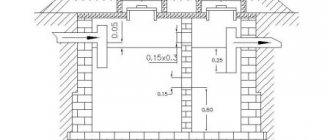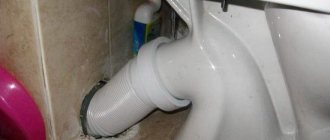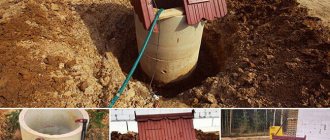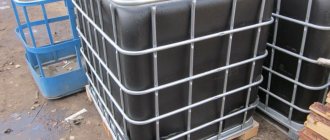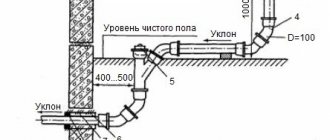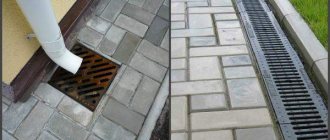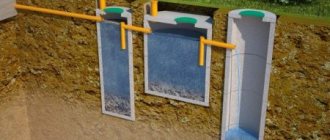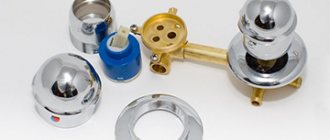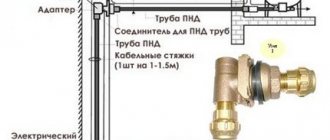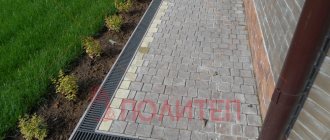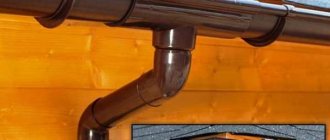Discharge of untreated sewage effluent is strictly prohibited. To dispose of wastewater in private homes, septic tanks are most often installed. In these installations, wastewater is settled and subjected to biological treatment. However, a conventional septic tank cannot provide a sufficiently high level of purification, so the water has to be further purified by installing an infiltrator for the septic tank.
An infiltrator or filter cassette is a device into which the water discharged from the septic tank enters. The purpose of installing infiltrators is additional liquid purification. This post-treatment option is especially good for small areas where it is not possible to build large filtration fields. Let's look at what this device is and how you can install it yourself.
Advantages
You can use different types of devices for additional purification of water that has already settled well in the septic tank. However, for private households, the most profitable option is an infiltrator. Externally, this device looks like a plastic box with no bottom. Its advantages:
- the possibility of removing wastewater to a shallow depth allows the use of soil post-treatment even when the soil water is shallow;
- the minimal weight of the plastic structure makes it easy to install yourself;
- the ability to organize high-quality post-treatment in a small area, so one infiltrator can replace 35 meters of drains in filtration fields;
- the design copes well with uneven flow of wastewater;
- the affordable cost of the structure and the ability to install it yourself allows you to reduce construction costs.
Installation of a factory infiltrator ↑
The installation of an infiltration unit can be done both at the stage of arranging a septic tank and after its construction. The factory model made of plastic, depending on the design and power, weighs only 10–20 kg. No cranes are required; everything can be carried by one person.
Installation of an infiltrator for a septic tank is carried out in three stages:
- Excavation work - digging a trench to fit the size of the equipment.
- Formation of a filtration layer from gravel.
- Installing the container and filling it with soil.
SNiP and SanPiN requirements! The septic tank and the infiltrator for it must be 5 meters away from the foundation of the house, and 30 meters from reservoirs and wells with drinking water.
The area of the pit on each side should be 30–50 cm larger than the size of the infiltration equipment. You will have to dig in depth based on the height of the plastic module plus 50 cm for the sand and gravel filter from below and the same amount from above for the soil as thermal insulation. It should be one meter away from the septic tank.
Installation diagram of the infiltrator and septic tank
After excavating the earth, crushed stone of medium fractions and fine-grained sand are poured into the bottom of the trench. The thickness of the layer depends on the hygroscopicity of the soil underneath. In most cases, 40–50 cm of gravel-sand or just a gravel cushion is sufficient.
All that remains is to install the infiltrator on the bottom and connect it with a plastic pipeline to the septic tank. After checking the connections for leaks, everything is covered with earth - it will provide the necessary thermal insulation in winter and prevent the water inside from freezing. Only the ventilation pipe should be visible from above.
How does it work?
The process of water purification in the infiltrator proceeds as follows:
- water that has settled well in septic tanks contains a minimum of foreign inclusions;
- Through a pipe leading from the treatment plant, water enters the infiltrator, where it gradually seeps through the layer of crushed stone, finally being purified;
- thanks to the presence of ventilation, the water is not only mechanically filtered, but also undergoes biological purification under the influence of aerobic microorganisms;
- purified water is absorbed into the soil.
Advice! To ensure that the infiltrator lasts longer, geofabric is used during installation. A layer of crushed stone is wrapped in geotextile, so soil particles do not contribute to its siltation.
Infiltrator for septic tank Tank ↑
is a manufacturer of well-known anaerobic septic tanks of the Tan and Triton brands. Thanks to its own production of plastic products, it was the first on the Russian market to produce infiltrators as an additional option for a septic tank.
Photo: infiltrator for septic tank Tank
Currently, you can purchase the Triton 400 infiltrator with the following technical parameters:
- dimensions – 1800*800*400;
- wall thickness - 10 mm;
- design volume – 400 l;
- weight without connected pipes – 15 kg.
Depending on the model of the septic tank and the composition of the soil, a certain number of infiltrators are installed.
Photo: recommendations for selecting the number of Triton 400 infiltrators
How to choose?
Before installing an infiltrator with your own hands, you need to choose the right model. In this case, it is necessary to take into account the performance and other characteristics of the equipment, as well as the cost of the equipment and the complexity of installation work. Experts recommend taking into account when choosing:
- One of the most important criteria is volume. The design for post-treatment must exceed the productivity of the septic tank by at least three times. Only in this case will the aftertreatment system be able to operate effectively during peak load periods.
- An equally important selection criterion is the characteristics of the soil. The higher the soil permeability, the fewer infiltrators will be required to organize additional treatment with equal septic tank performance.
Advice! For example, for a septic tank that purifies up to 0.6 liquid per day, provided it is installed in sandy soil, it is sufficient to install one infiltrator with a capacity of 0.4 m³. If the site has loam, then the number of installations for post-treatment needs to be doubled; they are installed sequentially.
Most popular models
Today there are different options for infiltrators on the market, the most popular models are:
- Triton-400;
- Polex-300.
Characteristics of the Triton model:
- total volume – 400 liters;
- overall dimensions 1.8 x 0.8 x 0.4 meters;
- weight – 15 kg.
Characteristics of the Polex model:
- total volume - 300 liters;
- overall dimensions – 1.22 x 0.8 x 0.51 meters;
- weight – 11 kg.
Criteria for choosing a wastewater treatment system
When choosing a device, you need to consider a number of factors:
- Soil properties. First of all, it is necessary to examine the composition of the soil for water absorption into the soil; the required volume of the structure depends on this. If you have sandy soil on your site, it can allow more moisture to pass through than loam, therefore, in this case, a smaller number of drainage devices will be sufficient for the proper functioning of the system.
- Technical characteristics of the treatment plant. To avoid problems and to ensure uninterrupted operation of the infiltrator during a volley discharge of the septic tank, it is necessary that its capacity be three times greater than the capacity of the septic tank.
- The volume and area of the infiltrator are its main parameters.
Installation
It is quite possible to install the infiltrator yourself. As a rule, the installation of a septic tank and a device for post-treatment is carried out simultaneously, but it is possible to install infiltrators after completion of the installation of a local treatment plant.
First of all, you need to choose the location of the local treatment plant, and the location is chosen not only for reasons of convenience, but also taking into account construction and sanitary standards.
Advice! Despite the fact that the water that is absorbed into the soil is maximally purified from impurities, the post-treatment system must be located at the maximum distance from sources of drinking water. The minimum distance is determined by the permeability characteristics of the soil and ranges from 30 to 80 meters.
The infiltrator is placed at a distance of 1-1.5 meters from the septic tank, the devices are connected by laying a pipe. Here are the basic installation rules:
- First you need to prepare the pit. Its dimensions depend on the dimensions of the infiltrator, and the size of the pit should be half a meter greater than the length and width of the plastic container. The depth depends on how high the soil water rises.
- Next, you will need to begin forming the filter layer. It consists of medium fraction crushed stone and river sand. To prevent rapid siltation of the filter layer, it is necessary to wrap the filter layer with geotextile. This is done like this: the bottom of the pit is covered with geofabric so that the edges of the material protrude beyond the boundaries of the pit. Then crushed stone is poured in a layer of 50 cm, after which an infiltrator is installed, and the edges of the geofabric are lifted up and laid over a plastic container with an overlap.
- After installation, you need to check the correct installation using a level, since the liquid must move by gravity, the pipes must be laid with a slope.
- The incoming pipe is connected, as well as the ventilation pipe is installed; all connections in the installation must be sealed.
- Then a layer of sand is poured over the plastic container and a layer of geofabric, which is carefully compacted.
Proper installation is a guarantee of trouble-free service of the local sewerage system. So, if the installation is carried out with errors, the infiltrator may float up in the spring, destroying the entire post-treatment system.
So, the advantages of using infiltrators for post-treatment of wastewater are obvious. These devices ensure the environmental safety of using septic tanks; at the same time, they take up little space and can be used even if the soil water rises quite high on the site. If the groundwater level is very high, it is possible to install an infiltrator on the surface of the ground, but in this case, the circuit will have to include a pump that will pump water from the septic tank to the infiltrator.
What is it and why is it needed
Structurally, the infiltrator is a plastic container without a bottom, externally resembling a basin that has been turned over . It should be mounted at a distance of 1-2 m from the septic tank.
Promotes the removal of wastewater into the upper layers of the soil, which helps to clean it more completely.
- Infiltrators are lightweight , but at the same time have a sufficient margin of safety.
- They can be used in any type of soil.
- One such device successfully replaces up to 800 kg of crushed stone and up to 40 meters of drainage pipes.
- Large volumes help cope even with peak wastewater emissions.
- Installation of the infiltrator is not difficult , and further operation does not require constant monitoring.
- It is characterized by low cost , while protecting the site from waterlogging and reducing the amount of work when arranging the sewer system.
When and who needs such a device? In a situation where wastewater is not completely treated by a septic tank. If the degree of purification is 75-98%, then installation of an additional element of the system is required .
Biofilters in action
You can further purify the liquid from a septic tank using a biofilter. It is a system of biological and mechanical treatment. The first layer is expanded clay, the second cavity contains aerobic bacteria that complete the process of breaking down organic matter. A biofilter for a septic tank is installed in the last chamber or mounted in a separate container. Maintenance requires regular introduction of bacteria, oxygen delivery, and year-round operation of the sewage system. Without regular access to organic matter, microorganisms in the filter will quickly die. A significant disadvantage of the devices is their high cost.
You can make a biofilter for a septic tank with your own hands without much effort. For this, an additional container is used, into which wastewater will flow from the second chamber. It is filled with filtration porous material. You can use expanded clay. Water passes through it and is mechanically purified. In addition, the container is populated by aerobic organisms. They decompose organic pollutants, performing additional wastewater treatment.
An aeration unit is additionally supplied to the chamber, which will enrich the wastewater with oxygen. For this, a septic tank compressor and a perforated pipe are used, which are located at the bottom of the tank.
